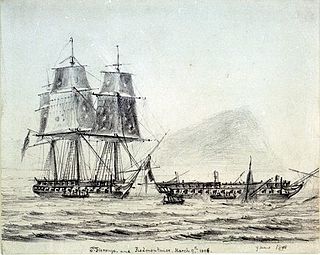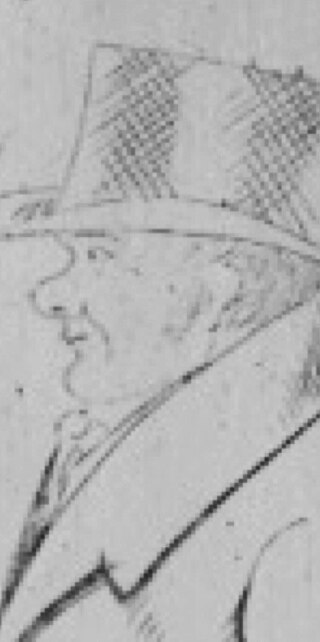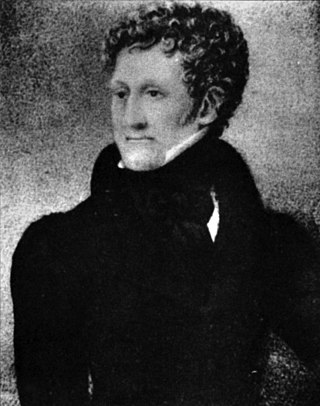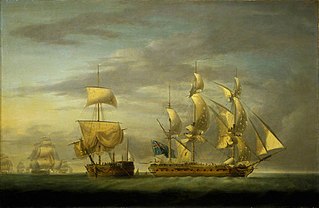
Admiral Sir John Thomas Duckworth, 1st Baronet, GCB was an English officer of the Royal Navy, serving during the Seven Years' War, the American War of Independence, the French Revolutionary and Napoleonic wars, as the Governor of Newfoundland during the War of 1812, and a member of the British House of Commons during his semi-retirement. Duckworth, a vicar's son, achieved much in a naval career that began at the age of 11.

Admiral Sir William Cornwallis, was a Royal Navy officer. He was the brother of Charles Cornwallis, 1st Marquess Cornwallis, British commander at the siege of Yorktown. Cornwallis took part in a number of decisive battles including the siege of Louisbourg in 1758, when he was 14, and the Battle of the Saintes but is best known as a friend of Lord Nelson and as the commander-in-chief of the Channel Fleet during the Napoleonic Wars. He is depicted in the Horatio Hornblower novel, Hornblower and the Hotspur.

HMS Berwick was a 74-gun Elizabeth-class third rate of the Royal Navy, launched at Portsmouth Dockyard on 18 April 1775, to a design by Sir Thomas Slade. She fought the French at the Battle of Ushant (1778) and the Dutch at the Battle of Dogger Bank (1781). The French captured her in the action of 8 March 1795 during the French Revolutionary Wars and she served with them with some success then and at the start of the Napoleonic Wars until the British recaptured her at the Battle of Trafalgar. Berwick sank shortly thereafter in a storm.

Rear-Admiral Sir Charles Cunningham KCH was an officer of the Royal Navy during the late eighteenth and early nineteenth century. He saw action during the American War of Independence and the French Revolutionary and Napoleonic Wars, eventually rising to the rank of rear-admiral.

Admiral Sir Edward Joseph Hamilton, 1st Baronet KCB was an officer of the Royal Navy, who saw service during French Revolutionary and Napoleonic Wars, eventually rising to the rank of admiral.
Admiral Sir Robert Laurie, 6th Baronet KCB was an officer of the Royal Navy who served during the French Revolutionary and Napoleonic Wars. He rose through the ranks after his entry, fighting as a lieutenant under Howe at the Glorious First of June, and being wounded in the action. Shortly after he served in the West Indies and off the American coast, where he operated successfully against enemy raiders and privateers, he was rewarded with the command of the frigate HMS Cleopatra, and in 1805 fought an action with a superior French opponent, Ville de Milan. He was forced to surrender his ship after several hours of fighting, but so heavily damaged the Frenchman that both she and the captured British vessel were taken shortly afterwards when another British frigate HMS Leander, arrived on the scene. Rewarded for his valour and honourably acquitted for the loss of his ship, he served throughout the rest of the Napoleonic Wars. He rose to flag rank after the end of the wars, eventually dying in 1848 with the rank of Admiral of the White. He inherited a baronetcy in 1804, but this became extinct upon his death.

Minerve was a 40-gun frigate of the French Navy, lead ship of her class. She operated in the Mediterranean during the French Revolutionary Wars. Her crew scuttled her at Saint-Florent to avoid capture when the British invaded Corsica in 1794, but the British managed to raise her and recommissioned her in the Royal Navy as the 38-gun fifth rate HMS St Fiorenzo.
Vice-Admiral Sir Thomas Bertie KSO was an English officer of the Royal Navy who served during the American War of Independence and the French Revolutionary and Napoleonic Wars.

Samuel Sutton was an officer in the Royal Navy. He entered the service shortly after the start of the American War of Independence, and spent most of his early career serving with Captain and later Admiral Joshua Rowley. He saw action at several engagements with the French fleets in the West Indies, and ended the war as a lieutenant. Left without active employment by the following years of peace, Sutton briefly returned to service during the Spanish Armament in 1790, but the outbreak of the French Revolutionary Wars in 1793 brought him steady work. After serving on a number of ships and being present at Cornwallis's Retreat in 1795, Sutton received command of a sloop, and with it the opportunity to render a service to a member of the French aristocracy, and the future Charles X of France. Promoted for his good service, Sutton served as a flag captain to several admirals, including Horatio Nelson. He briefly commanded HMS Victory, before surrendering her to Thomas Hardy, who would go on to command Victory at Trafalgar, and be present at Nelson's death. Sutton instead took command of a frigate, and in 1804 was involved in a controversial action that saw the capture of three Spanish frigates and the destruction of a fourth. Made wealthy from the spoils, Sutton nevertheless remained in the navy, taking part in the chase of the French fleet to the West Indies in 1805. His health declined during this period, and he went ashore in October that year. He retired from active service, and served as a magistrate and local official for his community, being promoted to rear-admiral in 1821 and dying in 1832.

Sir Hugh Cloberry Christian KB was an officer of the Royal Navy who saw service during the American War of Independence, and the French Revolutionary Wars.
Admiral Sir Lawrence William Halsted GCB was an officer of the Royal Navy who served during the American War of Independence and the French Revolutionary and Napoleonic Wars.

John Perkins, nicknamed Jack Punch, was a British Royal Navy officer. Perkins was perhaps the first mixed race commissioned officer in the Royal Navy. He rose from obscurity to be a successful ship's captain in the Georgian Royal Navy. He captained a 10-gun schooner during the American War of Independence and in a two-year period captured at least 315 enemy ships.
Rear-Admiral James Walker CB, CvTE was an officer of the Royal Navy. He served during the American War of Independence, and the French Revolutionary and Napoleonic Wars.

Rear-Admiral James Macnamara was an officer of the Royal Navy who served during the American War of Independence and the French Revolutionary and Napoleonic Wars.
Sir Henry Heathcote was an officer of the Royal Navy who served during the French Revolutionary and Napoleonic Wars.
Rear-Admiral George Sayer CB was a Royal Navy officer who twice became Commander-in-Chief of the East Indies Station.
Edward Hawker was an officer of the Royal Navy who served during the French Revolutionary and Napoleonic Wars.
Robert Murray was an officer in the Royal Navy who served during the American War of Independence and the French Revolutionary and Napoleonic Wars.

Admiral Sir George Parker, KCB was a British Royal Navy officer.
Admiral Thomas Le Marchant Gosselin was a British naval officer of the 18th and 19th centuries who received the patronage of senior officers such as Samuel Hood, 1st Viscount Hood and William Cornwallis. Gosselin joined the Royal Navy in 1778 and as a junior officer had extensive service in the American Revolution, including participating in the Battle of the Saintes in April 1782. Promoted to commander in April 1793, Gosselin took part in the Glorious First of June as commander of HMS Kingfisher. He was promoted to post-captain in July 1795 and took command of a variety of ships including most notably HMS Syren, HMS Latona, and HMS Audacious. Gosselin frequently served on blockade duties in the English Channel and on convoy duties to and from the West Indies.










